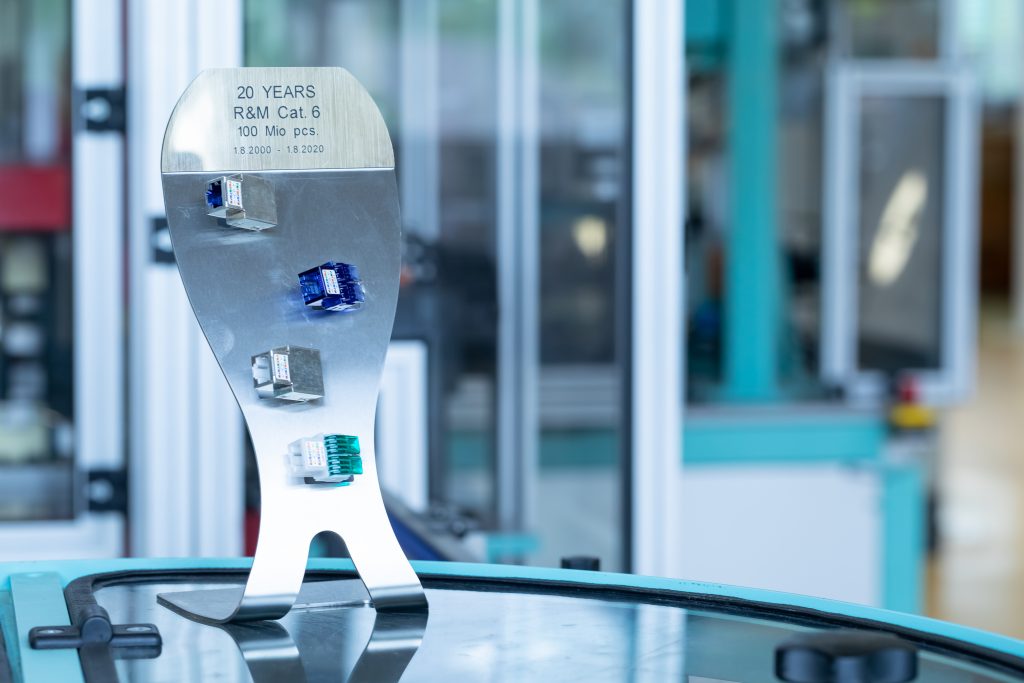Twenty Years of Cat. 6

The key to the Gigabit age is celebrating its twentieth anniversary: the Cat. 6 connection for data networks. It revolutionized data traffic, brought broadband Internet to the workplace, and pointed the way toward digitalization. R&M is one of the Cat. 6 pioneers and, over the last twenty years, has produced more than 100 million modules of this type at its plant in Bubikon (Switzerland).
Cat. 6 connections with the universal, space-saving RJ45 plug-in format were responsible for a quantum leap in information technology at the millennium. Cat. 6 technology made it possible to increase the speed of genuinely usable data transmission compared to its predecessor Cat. 5e and to increase the bandwidth to 250 MHz. Previously unimaginable amounts of data could then be transported in offices and buildings.
Today Cat. 6 is still the most frequently installed network connection worldwide. R&M estimates that there is a Cat. 6 connection module in every second outlet of data and communication networks.
Pioneering accomplishments
R&M was actively involved in Cat. 6 standardization in the international expert committees. Even before the transmission technology parameters were finally adopted, R&M went on the offensive in 1999. At the same time, a proprietary Cat. 6 module with a corresponding RJ45 connector was developed and a production facility set up in Bubikon, close to the company headquarters in Switzerland.
R&M was the first manufacturer to produce the Cat. 6 modules fully automatically and in zero-defect quality. The first thousand Cat. 6 modules were delivered to a customer in Winterthur on August 2, 2000. Today, 100 million R&M Cat. 6 modules installed worldwide ensure fast data transmission.
Swiss success story
R&M’s contribution to the start of the Cat. 6 age is a genuine Swiss success story. In 1999, the owners were persuaded to take the plunge by the development team. Agile management made it possible for the team to achieve all goals precisely within 18 months.
Thanks to the company’s involvement in the standardization committees, R&M was informed early on about the coming technologies. The entrepreneurial courage and commitment of the owner’s family, the trust in the employees, and the concentration of the entire company on one undertaking promoted the progress of the project. With Matthias Gerber, now Market Manager for LAN Cabling, R&M authorized a responsible project manager and created an autonomous project team.
Furthermore, the project would not have been possible without the long-standing contacts and the trusting relationship with suppliers. The unique entrepreneurial SME landscape in Switzerland was an important factor in this success. Specialized companies as well as toolmakers and automation engineers worked together flexibly, implemented ideas immediately, and continuously adapted components and processes as product development progressed.
R&M is proof that Switzerland can be a base for competitive production for the international market. It has been proven that long-term investment in Switzerland generates high-value creation. With RJ45 connection modules as core components, R&M again generated a substantial part of its sales with copper data cabling last year. As a Swiss manufacturer, R&M concentrates on premium markets that expect transmission performance and reserves to exceed standard parameters.
Most reliable technology
In 2000, R&M exceeded the demanding Cat. 6 component requirements with its first module on the market. The industry was soon referring to the R&M product as a «blue wonder module» because of its quality. It is still seen as «unbreakable» and as the most reliable network connection in the world. R&M is the only manufacturer in the Cat. 6 sector not to use printed circuit boards for compensation. This means the data signals flow transition-free directly from the cable connection via specially shaped metal tracks to the plug contacts.
R&M uses insulation displacement contact (IDC) technology to connect the wires. It is said to be load- and vibration-resistant with tensile strength, temperature- and moisture-resistant, dust- and gas-tight, and thus corrosion-protected. The contact resistance of an IDC connection is permanently low and stable over the entire lifetime of the product. In addition, the connectivity technology can be rewired up to 20 times.
The production facility in Bubikon tests each individual module fully automatically for return loss, crosstalk (NEXT), continuity, and high voltage resistance. The comprehensive quality assurance is seen as leading in the industry. The error rate has been below 1 ppm for 20 years. Amazing value and a reward for the employees and developers. With the Cat. 6 module, R&M established itself as the technically leading manufacturer and world brand for RJ45 adapters.
R&M still produces most RJ45 modules fully automatically in Switzerland, although for some time now, the plant in Poland has been successfully producing the Cat. 6A EL module, further development of the original Cat. 6 module. The systems are continuously being improved at both locations. This is why the R&M Cat. 6 modules are still state of the art even after 20 years. R&M uses the experience to develop subsequent module generations: Currently, the latest module, Cat. 8.1, is successfully establishing itself on the market.
The road to Gigabit Ethernet
In technical terms, it was a question of introducing the ISO/IEC 11801 standard (2nd edition) twenty years ago. The standard defined data transmission using the Ethernet/Internet protocol, with 250 MHz bandwidth and a speed of 1 Gigabit per second (1 Gbit/s) over 100 meters of twisted-pair copper cabling. In the meantime, further developments at IEEE have made it possible to significantly increase the data rate over Cat. 6 connections. Shielded Cat. 6 connections support data rates of up to 5 Gbit/s, for example.
Main application areas of the Cat. 6 connections are structured cabling for data networks in offices, data centers, factories, and functional buildings of all kinds. Cat. 6 modules transmit more and more electrical power in addition to data signals when Power over Ethernet (PoE) is used. PoE is used to supply end devices such as WLAN antennas, surveillance cameras, intelligent LED lights, and Internet of Things (IoT) devices with power via the data network. The Cat. 6 modules are also particularly suitable for PoE transmission thanks to the innovative contact design.








